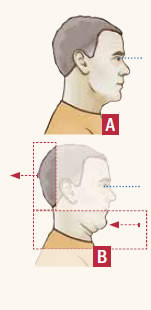Neck pain: Symptoms, causes, & how to relieve it
Often caused by poor posture, physical strain, and more, there are many ways to relieve neck pain.

Neck pain is a common condition. Problems in any of the parts of the neck, such as the muscles, nerves, bones (vertebrae), joints, and the discs between the bones, can cause it. When the pain or soreness makes it difficult to move the neck, the condition is usually called a stiff neck.
Causes and types of neck pain
Most people get neck pain for many of the same reasons they suffer low back pain. "In the vast majority of people, it's routine muscle aches and pains," says Dr. Robert Shmerling, Senior Faculty Editor at Harvard Health Publishing and Corresponding Member of the Faculty of Medicine at Harvard Medical School. "The neck has to support that heavy bowling ball on top."
Here are the most common causes and types of neck pain.
- Muscle pain. Aching or sore neck and shoulder muscles may occur in response to overexertion or prolonged physical or emotional stress. The neck muscles may develop hard knots that are tender to the touch, sometimes called trigger points.
- Muscle spasm. This is a sudden, powerful tightening of neck muscles. Your neck may hurt and feel tight or knotted, and it may be impossible to turn your head. When you wake up with a painful, stiff neck, that's likely a muscle spasm. Muscle spasm can result from a muscle injury, but it may also occur in response to a spinal disc or nerve problem, or even emotional stress. However, there is often no clear cause.
- Headache. Neck-related headache is most often felt in the back of the head and upper neck and is usually the result of muscle tension or spasm. Neck-related headache pain is usually dull or aching, rather than sharp; the neck might also feel stiff or tender. Moving your neck makes it worse.
- Facet joint pain. Often described as deep, sharp, or aching, pain in the facet joints (part of the vertebrae of the neck) typically worsens if you lean your head toward the affected side and may radiate to your shoulder or upper back. Arthritis in the facet joints, as in other locations, may feel worse in the morning or after a period of inactivity.
- Nerve pain. Irritation or pinching of the roots of the spinal nerves causes pain that may be sharp, fleeting, severe, or accompanied by pins and needles. Depending on the nerve involved, the pain may shoot down the arm or even into the hand.
- Referred pain. Referred pain is pain in one part of the body that is triggered by a problem in another part of the body. For example, neck pain that worsens with exertion may indicate a heart problem, while neck pain that occurs when you eat may stem from a problem in the esophagus.
- Bone pain. Pain and tenderness in the cervical vertebrae are far less common than neck pain from the soft tissues. Bone pain needs medical attention because it may signal a more serious health problem.
How to relieve neck pain
The remedies for neck and low back pain also have some things in common. First, ease the early intense pain with rest, ice, and heat; then move on to gentle stretching and strengthening exercises. Later, avoid bad posture and other habits that could trigger another neck pain crisis.
The causes of routine strain-and-sprain neck pain vary. If you wake up with a crick in your neck, it's probably the sharp muscle contractions known as spasms, caused by a muscle strain. A sprain, in contrast, happens in ligaments — the tough tissues that connect bones together. Alternatively, a tendon — the tissue that attaches muscles to bones — may become inflamed, causing tendinitis. Basic self-help takes care of most routine neck pain flare-ups:
- Use cold to numb the early acute pain and reduce inflammation.
- Take over-the-counter pain relievers to control mild to moderate pain. These include acetaminophen (Tylenol, generic brands) and nonsteroidal anti-inflammatory drugs (NSAIDs) like ibuprofen (Advil, Motrin), naproxen (Aleve), or aspirin.
- Use a neck collar for short periods to rest the painful muscles and tissues and ease your discomfort. "Collars have a bad reputation from people overusing them and getting weak muscles, but used a few hours here and there they can be very useful," Dr. Shmerling says.
- Apply heat — either with a heating pad or by using a warm whirlpool bath if one is available — after a day or two, once the acute pain calms down.
Should you go to a chiropractor to get your neck "cracked"? Dr. Shmerling counsels against sudden, strenuous manipulation of the neck. "It may be fine for low back pain, but I have concerns about its safety for neck pain," he says.
Stretches and exercises for neck pain
Exercises to stretch and strengthen the neck, shoulder, and upper back muscles can speed recovery from a painful neck condition and possibly reduce flare-ups, although the evidence for this is not ironclad. Dr. Shmerling encourages his patients to see a physical therapist for guided therapeutic exercise. Here is what the therapist can offer:
- Therapy will likely combine isometric and range-of-motion exercises. In isometric exercise, you tighten the neck muscles against an opposing force — such as your own hand, which you "push against" with your neck muscles. Range-of-motion stretches attempt to progressively relax and lengthen the neck muscles.
- Physical therapists can offer other therapies that, while not proven in research trials, seem to offer some people ease and comfort. One option is ultrasound treatment of the sore tissues with high-frequency sound waves.
- A physical therapist can also perform traction, using the hands or special equipment to gently stretch the neck muscles. You can also get equipment by prescription to perform neck traction at home, but follow the therapist's instructions carefully.
How to prevent neck pain
To ward off neck pain, it is helpful to take inventory of your posture or daily habits that could trigger neck pain, like sitting for extended periods in positions that strain the neck during reading, TV watching, computer work, or sleeping. Attending to the cause may stop some flare-ups of neck pain at the source.
When to see a doctor
If neck pain is severe, lasts for weeks or months, drastically limits your ability to move your head, radiates into the shoulders, or feels worse in the morning, consider seeing a doctor. Fever, weakness, or numbness in the arms are other red flags that warrant immediate evaluation. In some cases, an underlying physical problem, such as arthritis, an infection, or a compressed nerve, may be the cause. Depending on the diagnosis, you may need additional treatments or even surgery to relieve the pain and get back to your normal activities.
Simple neck stretch
[A] Look straight ahead. [B] Tuck your chin in slightly and move your head backward, slowly and smoothly. Be sure to keep your head level; you should be gliding your head backward, not bending or tipping it. Hold for five seconds. Repeat five times. Additional exercises for neck pain are available in Neck Pain: A troubleshooting guide to help you find relief, a Special Health Report from Harvard Medical School. Illustrations: Alayna Paquette |
Top Image: doucefleur/Getty Images
About the Author

Robert H. Shmerling, MD, Senior Faculty Editor, Harvard Health Publishing; Editorial Advisory Board Member, Harvard Health Publishing
Disclaimer:
As a service to our readers, Harvard Health Publishing provides access to our library of archived content. Please note the date of last review or update on all articles.
No content on this site, regardless of date, should ever be used as a substitute for direct medical advice from your doctor or other qualified clinician.

















